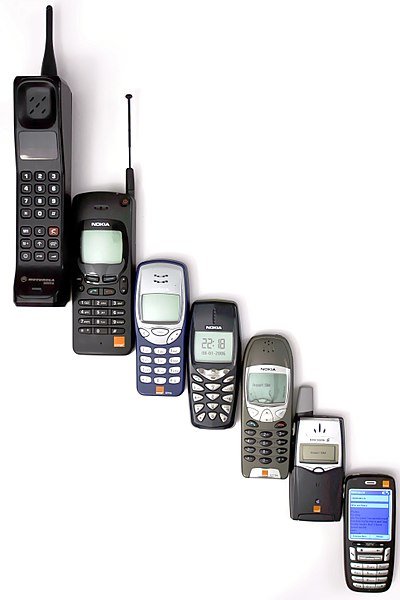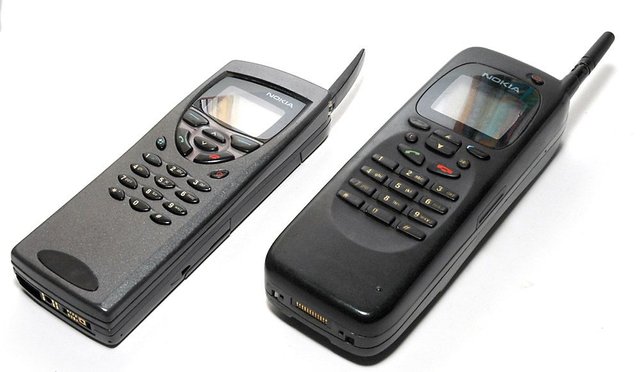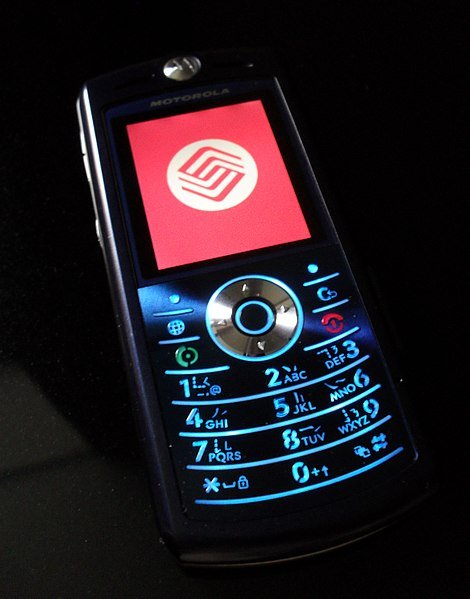Evolution and Revolution of Mobile Wireless Technology (from 0G to 5G)
 By Anders (Own work) [Public domain], Link
By Anders (Own work) [Public domain], LinkThe journey of mobile wireless communication technology started with Zero Generation (0G), First Generation (1G) followed by Second Generation (2G), Third Generation (3G), Fourth Generation (4G) and under research upcoming generation Fifth Generation (5G).
Evolution of Mobile Wireless Technology
The beginning of both evolution and revolution of mobile wireless communication technology industry can be traced back to early 1970. Mobile wireless communication technology have become much more pervasive and important than anyone could have imagine then, I could remember how costly my father bought his first mobile wireless phone in the year 2001, in fact, if I was told that mobile wireless phone could spread like this, I wouldn’t have believed.
The tremendous change in nature of service compatible transmission technology and new frequency bands is refers to as Generation.
ZERO GENERATION (0G)

Putput at the German language Wikipedia [GFDL or CC-BY-SA-3.0], Link
Zero Generation Technology can be traced back to an era which preceded modern cellular mobile telephony, mobile radio telephone systems was the name invoke then. The most recognized ancestor is the mobile telephone service, which was invented just after World War II. What was common then, is to ask a mobile operator to set-up the calls and there were only a handful of channels available then. Zero Generation (0G) refers to life before the invention of cell phone mobile telephony technology, this include radio telephones that some had in cars before the invention of modern cell phones. Technologies used in Zero Generation (0G) includes: Mobile Telephone System (MTS), Push to Talk (PTT), Advanced Mobile Telephone System (AMTS), Improved Mobile Telephone Service (IMTS), Norwegian for Offentlig Landmobil Telefoni (OLT), Public Land Mobile Telephony and Swedish abbreviation for Mobilelefonisystem D, or Mobile telephony system D (MTD), The B-Netz launched 1972 in Germany, The Autoradiopuhelin (ARP) invented in 1971 in Finland.
Mobile telephones system were always mounted in either cars or trucks, briefcase models were also manufactured though. The transceiver (transmitter receiver) was mounted in the vehicle trunk and usually placed to the head section, (dial, display, and handset) usually fixed close to the driver’s seat and they were spread through various outlets.
FIRST GENERATION

By Oldmobil (Self-photographed) [CC BY-SA 3.0], Link
First Generation (1G) maintained the analogue cellphone standards that were launched in the 1980s and spanned until the invention of an improved version called ‘2G digital mobile phones’. The first generation mobile wireless communication technology was analog frequency modulation system (FMS) and it was based on three (3) technologies known as Nordisk Mobile Telephony (NMT), Advance Mobile Phone Service (AMPS) and Cellular Digital Packet Data (CDPD). Nordisk Mobile Telephony (NMT) is by no doubt, the first full automatic cell phone system. It was launched in 1981 as a response to the ever increasing congestion and huge requirements of the mobile phone network’s manual. It has some unique features, such as the use of cellular technology that is building of hexagonal cells, Frequency 800-900 MHz, Data capacity 2KBPS and was built on Analog wireless Technology. Though there is no technology with advantages and leaves no disadvantages, First Generation (1G) has some challenges such as: It Allows voice calls in 1 country, poor voice quality, it makes use of analog signal, large phone size, limited capacity, poor hand off reliability, poor security and offered very low level of spectrum efficiency. These set of phones were the first mobile phones to be used.
SECOND GENERATION
The technology of second generation could not transfer data on email or any software let alone installing an application program on it, other than normal digital voice call and other basic daily usage such as time and date. It makes use of SMS messaging as a form of data transmission for some standards. In fact, the difference between First Generation (1G) and Second Generation (2G) is that the radio signals that First Generation networks used were analogue, while Second Generation networks are digital. Though, both First Generation and Second Generation Technologies used digital signaling to connect the radio towers which listen to the handsets down to the rest of the telephone system. The call itself is encoded to digital signals in Second Generation unlike First Generation which is only modulated to higher frequency (150 MHz and up).
THIRD GENERATION
This Generation of Mobile wireless Technology is based on a set of standards defined by The International Telecommunications Union (ITU) for mobile devices and mobile telecommunications use services and networks. some of the standards are: Mobile Phone could deliver not only voice, but also circuit switched data at speeds up to 14.4 Kbps. To also support mobile multimedia applications. The Third Generation Technologies finds application in wireless voice cell phone, video calls and mobile TV, fixed wireless Internet access and mobile Internet access .
FOURTH GENERATION
This is a successor to Third Generation (3G) and Second Generation (2G) groups of standards. Non-backwards compatible transmission technology and entirely make up of new frequency bands. Technologies such as mobile WiMAX and first-release Third Generation Long Term Evolution (LTE) which precede Fourth Generation Technologies have been in the market since early 2006 and 2009 respectively. Fourth Generation is just an extension of Third Generation technology with an enhanced bandwidth and services offers in the Third Generation. The main primary expectation for the Fourth Generation technology is high quality audio/video streaming over end to end Internet Protocol (IP).
A Fourth Generation Technology must provide standards defined by The International Telecommunications Union (ITU) for mobile devices and mobile telecommunications use services and networks. Current technologies inorporate an enhanced web access mobility, Internet Protocol Telephony, gaming services, high-definition mobile TV, video conferencing, and 3D television.
FIFTH GENERATION (5G)
Just like the aforementioned generations, Fifth Generation mobile wireless communication is a name used by researchers to denote the next major generation of wireless mobile communications standards. Most researchers claimed that the expected major difference between the current generations and the expected Fifth Generation Technology must be something else than an increased maximum throughput; other requirements include: Low battery consumption, better coverage and high data rates available at cell edge. Fifth Generation wireless mobile communication device seems to be the expected perfection level of wireless communication technology
SUMMARY AND CONCLUSSION
Antenna cell phone has become the memory of the past. Mobiles Technology is not only used for communication tool but also serves many other useful purposes. All the previous generation of wireless technologies have entertained and some are still entertaining the ease of phone and data sharing but Fifth Generation is bringing a new touch and making the life of mobile technology lively. The new Fifth Generation Communication Technology is expected to improve the services and applications offered by it.
Thanks for reading through, your thoughts are important.
References
1. The History and Evolution of Cell Phones By: Amanda Ray
2. The Evolution Of The Cell Phone—How Far It’s Come!
3. M Meraj and S. Kumar (2015). 'Evolution of Mobile Wireless Technology from 0G to 5G' International Journal of Computer Science and Information Technologies, Vol. 6 (3) , 2015, 2545-2551.
4. Meenal G. Kachhavay and Ajay P.Thakare (2014). 'EVOLUTION OF MOBILE GENERATION TECHNOLOGY: 1G TO 5G AND REVIEW OF UPCOMING WIRELESS TECHNOLOGY 5G'. International Journal of Computer Science and Mobile Computing, Vol.3 Issue.3, March- 2014, pg. 1080-1087
5. Evolution of Cellular Technologies
6. 0G mobile radio telephone/
7. Mobility Technologies and Standards
8. S. Mondal , A. Sinha and J Routh (n/d). 'Survey on Evolution of Wireless Generations 0G to 7G' International Journal of Advance Research in Science and Engineering- IJARSE, Vol-1, Iss-2
Image Credits
1. Wikimedia Commons
2.Wikimedia Commons
3. Wikimedia Commons
4. Wikimedia Commons
5. Wikimedia Commons
6. Wikimedia Commons
*All images are from free sources



This is awesome! I just remembered when Mobile phones were introduced in Nigeria. @noble-noah you did a great research. Well done!
Thanks @masterwriter. Verily, I am happy you read through and your nice comment is encouraging me more.
you just took me years back. pemi pada, owo n romi :). Nice one
Lol. Indeed, past is a good place to visit, but not a good place to stay. I can't just imagine taking TECHNOLOGY back to those days. Though we embraced it then just like we are embracing the current technology now. Thanks for the nice comment.
Cricket Wireless stands out as a top choice among non-contract cellular providers, known for its stellar call quality. They boast a range of affordable plans and products with flexible payment options, ensuring you find a phone and service that aligns with your needs and budget. What's great is they offer quality phones at competitive prices, often beating out other retailers, more info - https://cricket-wireless.pissedconsumer.com/review.html . This makes opting for their services not just convenient but also cost-effective in the long run.
Great effort seen on this write up @noble-noah.I just knew the meaning of the G behind the figures on my screen. 👍 @noble-noah
lol @steepup. Thanks for the nice comment.
this more like trow back of gadgets. i quite fulfilling to know that i meet the second generation. within a short period of time we have seen how phones have evolved from what they used to be to what they are now
a very educative post
Thanks @promise123